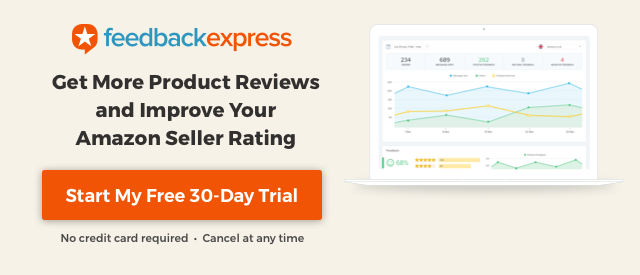Grabbing customer emails is one of the most effective ways to grow your ecommerce business. But Amazon also knows the value of customer retention, so they don’t want you taking their customer’s emails or information for your own use. This becomes a passive argument between you and Amazon for the “rights” to that customer.
In almost all cases, Amazon “owns” any customer who purchases through the Amazon platform—even if that customer purchases 100 of your brand’s products through Amazon. Amazon doesn’t allow you to take those customers for yourself, otherwise, they can suspend you or shut you down altogether.
But that doesn’t mean you should forgo email collection altogether.
In fact, you need to collect emails if you want your business to grow. You just have to be careful about how you go about doing so.
What is the value of building an email list as an Amazon seller? And how can you collect emails without breaking Amazon’s rules?
Why you need emails
Email marketing is one of the strongest forms of online advertising. The approximate return on investment for email marketing is around 122%. That’s because emails put you in direct communication with your consumer. You’re popping up in their inbox consistently, which helps foster long-lasting relationships.
What are the benefits of holding a list of customer emails?
1. Diversification
Even if 100% of your sales currently come from Amazon, you want to know that you hold some control over your clients. If Amazon were to kick you off tomorrow (even due to no fault of your own), a list of customer emails would mean you still had the ability to continue doing business. Otherwise, you’d be completely at a blank canvas with no sales, no reviews, and no clients.
Basically, capturing customer emails helps you grow a solid list of clients that holds the backbone to your business—no matter what happens with Amazon.
Customer emails aren’t just a backup plan, though. They’re a great starting point when you’re ready to expand off of the Amazon platform. Having customers on Amazon is great because they have a high intent to buy compared to consumers who are just browsing through social media or Google.
However, at some point, you might want to move on to your own platform as well so you have more control over your business’s growth (and so you don’t have to pay Amazon fees). Having an email list is a great way to make sure your business website launch is a success.
2. Relationships
Email marketing is one of the strongest ways to nurture customer relationships. You don’t have to sell with every email. You’re just showing up in their inbox with content and information, which shows off your brand voice and personality. This creates more credibility and trust, which encourages a deeper, long-term relationship with your customer.
Customer acquisition (getting new customers) costs significantly more than customer retention (encouraging repeat customers). This means that if you have no way to nurture your client list, you’re constantly throwing marketing money out the door looking for customers. If you rely solely on Amazon, you often sell to the “one and done” customer.
After a customer has purchased from you or even browsed your site, they’re showing interest in your product. You want to grab their email so you can continue to foster and grow that level of engagement. Emailing helps keep you top of mind while building a two-way interaction between consumer and business.
Email marketing allows you to be more than just an Amazon seller. It helps you create a brand voice that turns you into a substantial business. It also allows you to have greater control over your customer experience, which is critical towards creating a loyal client base.
3. Repeat business
The ability to stay in touch with your customers also gives you the ability to sell to them again. Emails help you stay top of mind while showing them new or relevant products that they might be interested in.
Interestingly, according to stats by RJ metrics, the more frequently someone purchases, the more likely they’ll purchase again. So, only 32% of first purchases will result in a second purchase. But 53% of second-time purchases will result in a third. The percentage keeps going up with the number of purchases.
So the more times you can get them to buy, the more loyal they become. This loyalty is the best way to boost sales, improve product reviews, enhance social proof, and grow your business overall. You can even direct them back to your Amazon listings to help you stand out above your competition.
Staying in touch with your customers through email marketing is the most direct way to encourage and market for repeat business.
4. Exit strategy
Every business should have a potential exit strategy. If you ever plan to sell your business, an email list makes you more valuable to purchasers. It shows that you have “customer capital” as a legitimate business and that you aren’t reliant on a third-party platform to gain customers.
When a buyer is looking to purchase your business, they’re buying your customers more than your product… So you need to have customers to give them.
How to collect emails
Gathering customer emails is critical to your business’s growth. But that doesn’t change the fact that Amazon doesn’t want you to steal their customers. In fact, it’s a direct violation of Amazon’s terms to solicit customer emails.
There are three Amazon regulations to be aware of when it comes to email marketing:
- You can’t divert transactions or buyers. That means you can’t use advertisements, marketing messages, or calls to action that encourage Amazon users to leave the Amazon website whatsoever. This means no using hyperlinks or emails on your product listing or in your seller-generated email confirmations after purchasing.
- You can’t send “inappropriate” email communications, meaning you can’t market through your seller-generated emails to Amazon customers.
- You can’t ask for or send emails directly. Buyers and sellers can only communicate through the Buyer-Seller Messaging Service.
If you violate any of these terms, Amazon can (and will) kick you off the site permanently. Amazon takes their customer retention very seriously.
So how do you get customer emails without upsetting Amazon?
You want to try to “meet” your customers before they purchase from Amazon. If you collect an email before they go to Amazon, they’re your customer. So you want to bring the customer to you, even when they’re already an avid Amazon user. Here’s how.
1. Use email opt-in forms on your website
Pop-ups or banners with opt-in forms are a great way to gather visitor information. You can offer a free newsletter or blog subscription, and they’ll be glad to give you their name and email address for more information.
You might be wondering: But what if they go to Amazon before they go to my website? According to Adweek, 81% of customers do product research before making a purchasing decision. That means that your customers might see your product on Amazon but then do a Google search of your brand elsewhere. Even though they may have found you first on Amazon, they’re actively going to your site—which means you can solicit them for emails as much as you want (within reason) on your own website.
2. Exchange content for email
A strong way to get customers to willingly give you their email address is by offering some sort of free content. This might be a PDF guide, a mini-course, a webinar, or a white page. You’re providing some sort of value to your customer for the low price of their email address.
This makes them more willing to give out their information, but it’s also an opportunity for you to build a relationship with them. If they’re downloading your content, they already have some interest in your business. This opens the door to further engage with the customer to eventually lead them towards conversion (whether on Amazon or on your own site).
3. Offer Amazon discounts
There is one “hack” that we like. Some services, like LandingCube, help you generate a landing page based on your Amazon listings. You can then offer a single-use promotion code in exchange for your customer’s email address. This will generate discounts to use for a specific Amazon listing.
You simply have to get your discount landing page in front of your customers. You can do this on your website, social media, blog, or paid advertisements. Put it wherever your customers are hanging out.
This incentivises your customer to give their email and make a purchase. This creates an Amazon-based sales funnel that both increases sales while helping you retain your Amazon customers.
Conclusion
You don’t want to get kicked off of Amazon by soliciting emails from their customers. And those Amazon “hacks” to find customer emails are toeing the line of Amazon’s Terms of Service.
Instead, find natural ways to interact with your customers off the Amazon platform by offering them value in exchange for their email. This gives you a strong client list that transforms you from a seller into a brand.
If you’re looking to grow your business into a more developed brand, check out the solutions at Seller’s Choice. Their marketing and listing optimisation can help you expand and transform your business effectively.
If you’re looking to automate your Amazon emails, then check out our sister company, FeedbackExpress. Free for 30 days, no credit card required.






